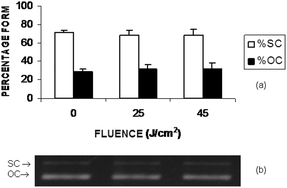Laser for treatment of aphthous ulcers on bacteria cultures and DNA
Abstract
Low-intensity red lasers are proposed for treatment of oral aphthous ulcers based on biostimulative effects. However, effects of low-intensity lasers at fluences used in clinical protocols on DNA are controversial. The aim of this work was to evaluate the effects of low-intensity red laser on survival and induction of filamentation of Escherichia coli cells, and induction of DNA lesions in bacterial plasmids. Escherichia coli cultures were exposed to laser (660 nm, 100 mW, 25 and 45 J cm−2) to study bacterial survival and filamentation. Also, bacterial plasmids were exposed to laser to study DNA lesions by electrophoretic profile and action of DNA repair enzymes. Data indicate that low-intensity red laser: (i) had no effect on survival of E. coli wild type, exonuclease III and formamidopyrimidine DNA glycosylase/MutM protein but decreased the survival of endonuclease III deficient cultures; (ii) induced bacterial filamentation, (iii) there was no alteration in the electrophoretic profile of plasmids in agarose gels, (iv) there was no alteration in the electrophoretic profile of plasmids incubated with formamidopyrimidine DNA glycosylase/MutM protein and endonuclease III enzymes, but it altered the electrophoretic profile of plasmids incubated with exonuclease III. Low-intensity red laser at therapeutic fluences has an effect on the survival of E. coli endonuclease III deficient cells, induces bacterial filamentation in E. coli cultures and DNA lesions targeted by exonuclease III.


 Please wait while we load your content...
Please wait while we load your content...